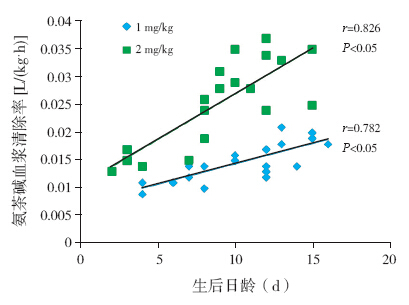 PDF(1254 KB)
PDF(1254 KB)


不同剂量氨茶碱在极低出生体重儿中的药代动力学及药效学研究
杨晓燕, 赵静, 石晶, 伍金林, 陈大鹏, 唐军, 熊英, 母得志
中国当代儿科杂志 ›› 2015, Vol. 17 ›› Issue (11) : 1171-1175.
 PDF(1254 KB)
PDF(1254 KB)
 PDF(1254 KB)
PDF(1254 KB)
不同剂量氨茶碱在极低出生体重儿中的药代动力学及药效学研究
Investigation of pharmacokinetics and pharmacodynamics of different doses of aminophylline in very low birth weight infants
目的 探索不同剂量氨茶碱在不同校正胎龄、体重及日龄的极低出生体重儿中药代动力学和药效学特点。方法 选取发生呼吸暂停的极低出生体重儿40例,予以负荷剂量(5 mg/kg)氨茶碱静脉注射后随机分为两组,分别给予不同维持剂量(1 mg/kg及2 mg/kg,每8 h给药一次)。在治疗后8 h、3 d、7 d监测血药浓度及肝肾功能,记录呼吸暂停发作情况,比较两组药代动力学数据。结果 2 mg/kg组的稳态血药浓度、血浆清除率明显高于1 mg/kg组,半衰期低于1 mg/kg组(P<0.05)。2 mg/kg组患儿生后7 d内呼吸暂停发作天数明显较1 mg/kg组少(P<0.05)。两组患儿的氨茶碱血浆清除率与生后日龄及校正胎龄呈正相关(P<0.05)。结论 极低出生体重儿中不同维持剂量氨茶碱药代动力学及药效学参数具有差异,2 mg/kg氨茶碱治疗呼吸暂停效果优于1 mg/kg;临床上对氨茶碱进行剂量调整时应考虑患儿校正胎龄及生后日龄,同时进行常规血药浓度监测。
Objective To study the pharmacokinetic and pharmacodynamic features of different doses of aminophylline in very low birth weight (VLBW) infants with different postmenstrual ages, weights, and ages (in days). Methods A total of 40 VLBW infants with apnea were enrolled. After an intravenous loading dose of 5 mg/kg aminophylline, they were randomized into two groups with different maintenance doses of aminophylline (1 mg/kg and 2 mg/kg, once every 8 hours). Blood concentrations of aminophylline and liver and renal functions were monitored at 8 hours, 3 days, and 7 days after the loading dose. Attacks of apnea were documented. Pharmacokinetic data of aminophylline were compared between the two groups. Results The steady-state plasma concentration of aminophylline and plasma clearance in the 2 mg/kg group were significantly higher than those in the 1 mg/kg group (P<0.05). However, the elimination half life was shorter in the 2 mg/kg group (P<0.05). Days of apnea attacks within 7 days after birth in the 2 mg/kg group were significantly fewer than in the 1 mg/kg group (P<0.05). Aminophylline plasma clearance was positively correlated with age (in days) after birth and postmenstrual age in both groups. Conclusions In VLBW infants, pharmacokinetics and pharmacodynamics are different when different maintenance doses of aminophylline are given. The maintenance dose of 2 mg/kg is associated with a better effect in the treatment of apnea. Postmenstrual age and age (in days) should be considered during the adjustment of dose, and routine blood concentration monitoring should be performed.

氨茶碱 / 药代动力学 / 药效学 / 维持剂量 / 极低出生体重儿
Aminophylline / Pharmacokinetics / Pharmacodynamics / Maintenance dose / Very low birth weight infant
国家临床重点专科建设项目(1311200003303);成都市科技惠民项目(2014-HM01-00058-SP);四川省科技厅科技支撑项目(2013SZ0028);国家自然科学基金青年基金(81300524);四川省卫生和计划生育委员会科研课题(150104);四川省医学科研青年创新课题(Q14036)。